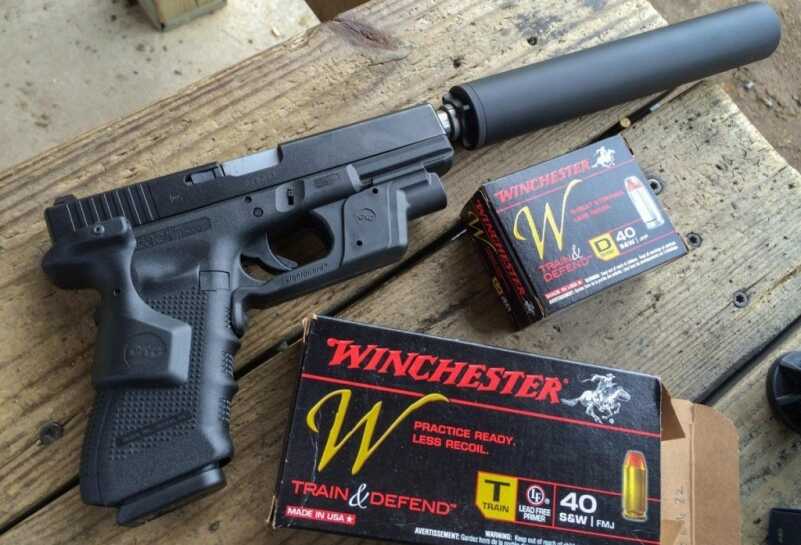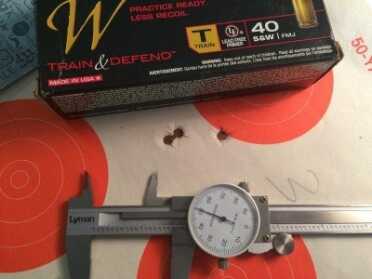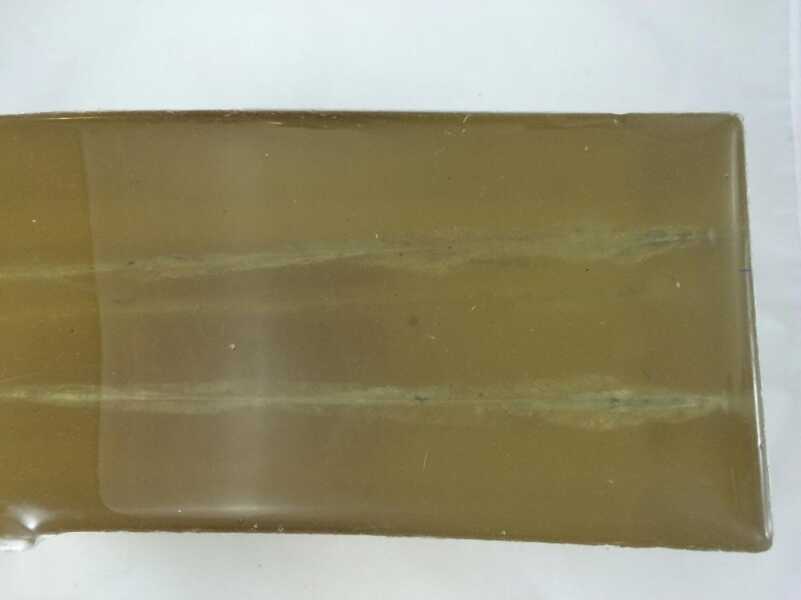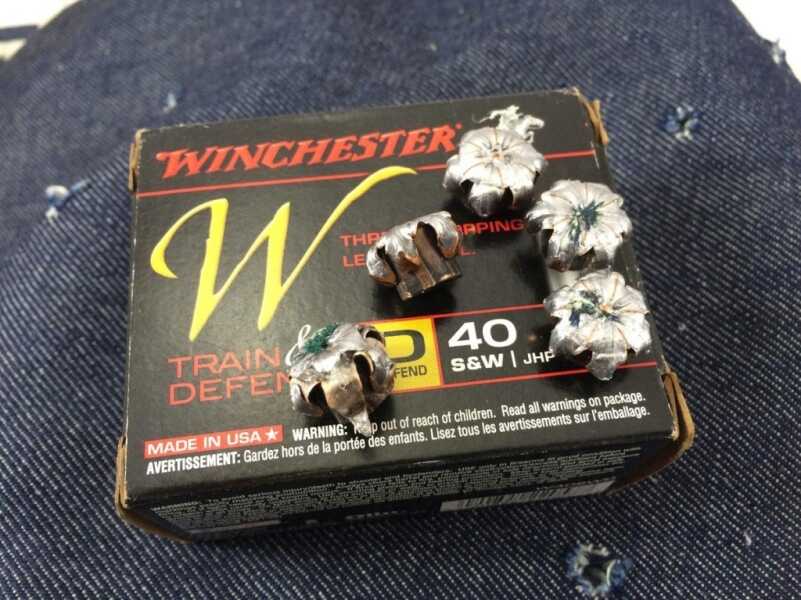
We tested the .40 S&W Winchester Train and Defend in several different guns including this suppressed Glock.
One of the first questions I ask when testing a new product of any kind is “What’s different or unique about this?” In the case of Winchester Train and Defend Ammunition, there are a few “unique” elements to consider.
 It’s simple, especially for newer shooters. For practice, use the boxes marked Train. When you load your gun with self-defense ammo, use the boxes marked Defend. When we live this stuff day in and day out, it’s easy to forget that newer shooters don’t necessarily know the difference between practice and defense ammo. If you use defense ammo to practice, you’ll spend a lot of money. If you use practice ammo for defense, it won’t be nearly as effective.
It’s simple, especially for newer shooters. For practice, use the boxes marked Train. When you load your gun with self-defense ammo, use the boxes marked Defend. When we live this stuff day in and day out, it’s easy to forget that newer shooters don’t necessarily know the difference between practice and defense ammo. If you use defense ammo to practice, you’ll spend a lot of money. If you use practice ammo for defense, it won’t be nearly as effective.
The two variants, Train, and Defend are designed to act and feel similar. The Defend ammo has premium expanding projectiles and low-flash powder, while the Train version does not. However, the weight of the bullets and associated recoil feeling are similar – by design. Your defense ammo will behave in your gun just like the practice stuff you take to the range.
It’s standard pressure ammo, not jacked up +P+Infinity+ stuff. The reason is for controllability. Recoil is less and muzzle flip is minimized, allowing the shooter to make accurate hits and faster follow up shots.
So that’s what’s supposed to be different about Winchester’s Train and Defend, so is it? Let’s take a look a the .40 S&W loading to see.
Function
Like most brand name ammunition, reliable function was a non-issue. I fired it from three different .40 S&W guns, a Beretta PX4, and FNS 40 and a Glock 22. Technically, it was a Glock 31 (.357 Sig) but I swapped out the barrel with a Lone Wolf .40 S&W conversion barrel, essentially making this gun functionally identical to a Glock 22. For you techies, yes, the Lone Wolf has traditional rifling unlike the octagonal rifling in factory Glock barrels, but that won’t make any significant difference in testing here.
As expected, this ammo runs fine, at least in these two guns. Besides, most malfunctions are magazine and gun related anyway, so no big surprise here.
Velocity
I set up my Shooting Chrony Beta Master Chronograph 15 feet downrange and proceeded to clock some rounds. Here’s what I found when I fired both the Train and Defend versions from a Glock 22.
Winchester Train .40 S&W Average velocity: 885.3 feet per second
Winchester Defend .40 S&W Average velocity: 907.7 feet per second
Accuracy
For accuracy, I mounted a Bushnell Elite 3500 Handgun scope on all three handguns. How, you ask? I used the UM Tactical Rail mount, which attaches to the Picatinny rail on a semi-automatic pistol and wraps around the slide. This provides a scope mounting platform up top that does not interfere with the semi-auto cycling of the slide. It’s a really cool solution. The Bushnell Elite 3500 provides up 2x to 6x magnification with plenty of eye relief. This setup allows me to obtain very precise sight pictures at 25 yards, even with my failing eyesight. Yes, I still have to do my part and manage the trigger, but fixing the sight picture takes most of the human error element out of the equation. I used sandbags stabilized by a 25-pound bag of lead shot to provide a solid shooting platform on a sturdy wooden bench.
I fired 5-shot groups and measured best three shots to factor out some of the human error.
Winchester Train, Beretta PX4: 1.8”
Winchester Train, FNS 40: 1.6”
Winchester Defend, Beretta PX4: 2.1”
Penetration
For the five rounds fired through the four-layer FBI fabric and into the gelatin blocks, penetration was excellent.
1: 14”
2: 15”
3-5: 16+”
I used Clear Ballistics gelatin blocks with old kevlar vest as a backstop. Three of the rounds barely exited the block and were stopped by the vest. They did not appear to have enough velocity to do much at that point, so if I had to assume, they might have stopped on their own accord in 17 inches or so of ballistic gelatin.
Expansion
To be honest, as these are standard pressure rounds at the full 180-grain weight, I was not sure that I would see both excellent penetration and consistent expansion. I was pleasantly surprised. After passing through four layers of the FBI fabric, one of which is denim, all rounds expanded in picture perfect fashion. As you can see from the photos, not too little and certainly not too much. You couldn’t ask more from this very controllable round.
A visual inspection didn’t show any obvious core and jacket separation, so I weighed each of the five recovered bullets. I also measured the maximum diameter of each to get a better idea of how much they expanded from the original .400 inch diameter.
You’ll see that a couple of recovered projectiles weighed more than the original 180-grain weight. That’s because they picked up some bits of fabric while passing through, and I could not have removed it all without altering the shape of the expanded bullet.
Closing Arguments
This particular load really surprised me, and here’s why. Velocity makes a big difference when it comes to reliable and consistent expansion through cloth barriers. Lighter weight .40 S&W projectiles cook along at a pretty good clip, but because of that pesky physics stuff, the upper end of the weight scale 180 grainers aren’t moving all that fast. Additionally, this particular load is standard pressure, so velocity is just over 900 feet per second from an “average” handgun. Yet, expansion was picture perfect and penetration was right where we wanted to see it. That tells me that a lot of effort went into the design of this .40 caliber projectile. It opens easily enough to expand at low(er) velocity, but not so much as to limit penetration performance. Consider me impressed!





No comment here, but a few questions… Which gun (barrel length) did you use for the gel tests? At what distance from the gel are you during these tests? What were the diameter measurements?
Thank you much for doing and publishing all of these tests!
I like the 40S&W round and I trust Winchester to make a good one….I carry PDX1 hollowpoints. The PDX1 is a bonded bullet and it is loaded a little hotter than the train&defend line. The 165 grain gets more velocity, but if you prefer 180 grain, they have that as well.( PDX1 180 grain)